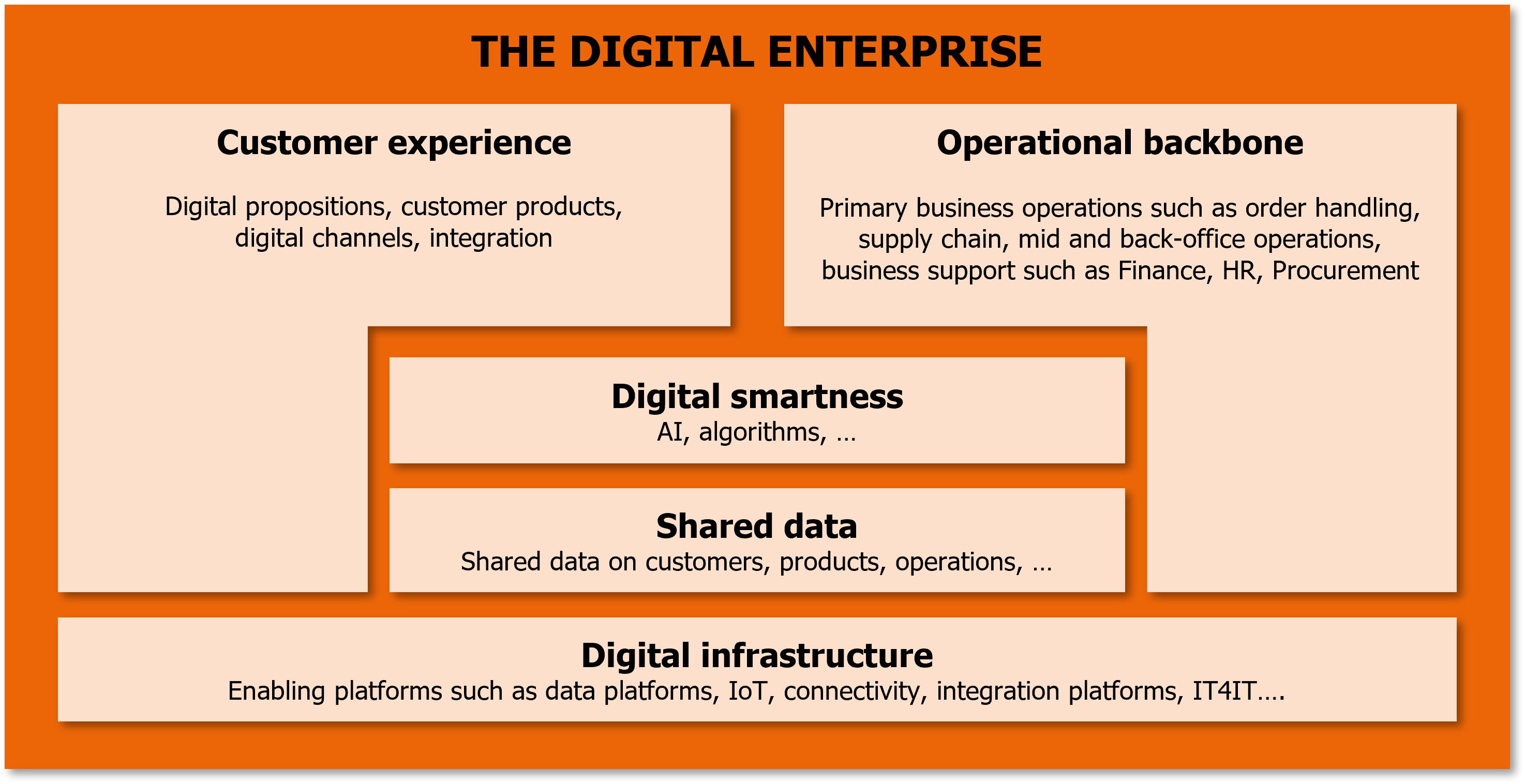
Building blocks of a successful digital enterprise
Five building blocks give digital enterprises their right to exist: customer experience, operational backbone, digital infrastructure, shared data and digital smartness. All these five components are strongly interrelated, to ensure smooth internal processes and the desired interoperability with the external digital ecosystem.
Use the bricks below to quickly navigate to the building block you want to know more about.
Customer experience
What makes a customer choose your product over countless others?
Delivering an exceptional customer experience is about well-crafted digital propositions, innovative customer products, effective digital channels, and seamless integration. This domain is particularly important for B2C organizations. It is a domain of speed and adaptability towards the market.
Organizations often start by turning their existing products and solutions into digital services. Deployment of technology and data causes people to start thinking about issues such as long-term customer value and the introduction of, for example, subscription models and other forms of value creation. Modern digital leaders create capabilities for the realization of new digitally based business models.
Balancing front end and backbone
The best digital companies not only work on the highly visible digital front end in terms of customer experience and customer interaction, but also on the seamless connected digital backbone of their primary value chain.
Rituals’ customer experience
Lifestyle cosmetics brand Rituals, for instance, uses personalized shop windows, loyalty programs, and innovative digital services to enhance customer satisfaction and redefine expectations. Their connected digital backbone supports a great front end experience, facilitating smooth operations and robust customer interactions.
Rituals creates an almost unparalleled and unique experience, in terms of products and customer journeys. The company is building a global brand through a variety of touchpoints: over a thousand of its own stores and more than three thousand shops-in-shop, e-commerce, wholesale through third parties and travel: sales at airports by airlines and in hotels.
Despite their own profit and loss account and autonomy, these business activities must be able to scale up within the bigger picture. The digital competence within Rituals is part of the foundation just like IT, marketing and fulfillment. Customer data and transactional information are crucial components in the data architecture, which is similar across all countries.
Rituals’ relatively modern and open central IT architecture is a big advantage for strengthening its connection with customers worldwide. Everything in the backend is cloud- and SaaS-based, combined with an integrated set of best-of-breed applications. This makes it relatively easy to add the same optimal front end worldwide.
Want to dive deeper into customer engagement and value?
Operational backbone
What drives true scalability and efficiency in modern enterprises?
The key lies in their operational backbone. By automating processes and minimizing human actions, companies can achieve remarkable efficiency. This backbone extends beyond internal operations to include seamless integration with ecosystem partners like logistics companies and suppliers of both physical and digital components.
In the backend, the focus shifts to modernizing and simplifying outdated IT environments to enhance chain efficiency and data exchange. Ensuring these systems connect well with front end processes, teams prioritize efficiency, stability, and standardization. This is particularly vital for B2B companies, which benefit greatly from scalability.
Importance of the operational backbone
For many organizations, the operational backbone encompasses everything from ERP implementations to full automation of production environments. This domain accounts for about 40 percent of IT investments, reflecting its importance. Mutual connectivity of systems, driven by IoT and APIs, is also becoming crucial, especially in the context of Industry 4.0 and supply chain collaboration.
SPIE’s future proof backbone
Take SPIE, a multi-technical service provider, as an example. With strong growth driven by mergers and acquisitions, SPIE operates in sectors where technology is fundamental—energy, factories, and infrastructure. According to Lieve Declercq, general director of SPIE Netherlands, “IT is defining the future of SPIE’s customers, and therefore our own.”
To deliver smart asset management, predictive maintenance, and managed service contracts, SPIE needed a robust information provision. The company developed an integrated IT strategy from the board level, translating it across all divisions and functions. Implementing a modern, future-proof IT environment became the foundation for optimal business results.
Digital infrastructure
What makes your organization function and grow in a connected world?
It’s the digital infrastructure. Just as roads and utilities are vital in the physical world, a robust digital infrastructure enables the seamless operation of modern enterprises. This includes not only hardware and software but also cloud infrastructure, IoT sensors, cybersecurity measures, and connectivity tools like networks and API.
The evolution of infrastructure
Harvard professor Michael Porter introduced the term ‘firm infrastructure’ in 1998 for supporting matters such as buildings, communications, administration, energy supply and physical security. While these remain foundational, digitalization has transformed the character of infrastructure. Today’s digital infrastructure is a critical provision that supports everything from daily operations to strategic growth.
Digital infrastructure includes hardware and software, which are increasingly being replaced by cloud infrastructure. It also involves IoT sensors, cybersecurity measures, workspaces, phones, laptops, and everything related to connectivity: networks, routers, devices, APIs, and identity & access management. In the digital age, everything is connected to everything.
PostNL’s integrated infrastructure: a strategic advantage
Take PostNL, for example. This logistics company has equipped 55,000 deliverers with advanced handheld devices for tracking packages. The seamless integration of these devices with various systems is crucial for transparent and efficient logistics. Additionally, PostNL’s digital infrastructure includes advanced data platforms for secure data collection, storage, and streaming. The integration with the operational technology for robotized processes such as processing, transport and traceability of mail and parcels is also part of the digital infrastructure.
Within PostNL and other organizations, a strong digital infrastructure is not just a technical necessity but a strategic advantage. It supports software developers and data analysts, facilitates continuous integration and development (CI/CD), and ensures optimal IT management. This foundational element allows organizations to innovate and scale effectively, keeping them ahead in a competitive landscape.
Shared data
How connected is your data?
Data is/becomes an asset because it’s crucial for delivering exceptional customer experiences, optimizing processes, and enabling intelligent, data-driven decisions. Yet, many organizations struggle with fragmented, non-integrated systems.
The challenge is that data within large organizations is traditionally locked up in various non-integrated systems. Large-scale consolidation of this fragmented data used to be mainly driven by the financial department. The need for clear data about customers, products, prices and employees is growing exponentially. This frequently used, crucial master data must always be properly managed and accessed centrally.
How platforms with high data quality are boosting shareability
Remember, everything that can be made possible with smart algorithms and AI – systems requires a solid data foundation. The algorithms and models learn from available data.
To effectively share data, organizations must ensure the quality, definitions, timeliness, and security of that data to maximize usability. A growing number of organizations are establishing data platforms as part of their infrastructure. These platforms make information accessible from and between various source systems.
How ANWB faced their data sharing challenges
The Dutch mobility organization ANWB, similar to its counterparts ADAC in Germany and the British AA, offers a range of services including roadside assistance, insurance, and travel and leisure products. These services are available to both members and non-members through online channels and physical stores.
ANWB faces challenges in exchanging information about its diverse customer base across departments and organizational units. Ensuring data quality, accessibility, and clear agreements on data ownership, management, and access is essential. Employees and other users must be properly identified and authorized to manage and access this data.
Without these measures, organizations and their leaders will lack critical insights into the most profitable products, individual customer preferences, and other key aspects of business operations, leading to negative consequences.
Digital smartness
How would you like AI to impact your organization, now and in the future?
Since the early 1980s, both science and industry have worked with algorithms, machine learning, and artificial intelligence, with the promise that AI would surpass the impact of the internet and the industrial revolution.
Despite the anticipation, the core principles remain unchanged. Today’s advanced systems are essentially refined extensions of the information revolution, powered by enhanced computing capabilities, the Internet, and an expanding pool of algorithm developers. These systems rely on statistical models to generate and recognize patterns, now more sophisticated and data-driven. The results are impressive. AI can efficiently handle customer queries, optimize delivery routes, and more.
Towards symbiosis of human and automated action
AI and analytics are transforming both customer experiences and operational efficiency. It enhances customer interactions through segmentation, personalization, and next-best-action models. Also, it strengthens the operational backbone of organizations with smart processing and automated decision-making.
The most likely future is that of a symbiosis of human and automated action. With software that is smart enough to indicate when human action is needed to prevent problems. This way you integrate the human touch into an automated process, which is an important characteristic of a mature digital enterprise.
Example: consumer due diligence in banking
Consider consumer due diligence at banks. Previously, assessing vast amounts of customer data required hours of manual work by numerous employees. Today, this task is automated, reducing the time per customer to mere minutes with follow-up checks. This evolution redefines the interplay between human and software roles.
While software excels in data-driven decisions, human intelligence is indispensable for nuanced judgment, such as policyholder acceptance or taxpayer assessment. Thus, a balanced integration of human insight and automated processes is crucial.

Building a digital enterprise is ‘Chefsache’
Building a digital enterprise requires strategic oversight at the highest level. You need a clear vision of your organization’s direction, understanding your unique market value, and how you fit within the broader ecosystem. This vision must translate into precise requirements for processes, people, data management, and IT support. Transforming your organization digitally is a responsibility that demands your direct involvement and leadership.
Take charge now, evaluate your strategy, align your resources, and lead the transformation of your organization. We’ve helped countless organizations towards becoming a successful digital enterprise. Contact one of our passionate professionals to discuss what the next best move forward is for your organization.
Feel free to get in touch with:
Featured client stories
Vision and perseverance in digital transformation of SPIE
SPIE
“The commitment of Anderson MacGyver is phenomenal; they are external but really part of the team. They never compromise on quality.”
The multimodal transformation of PostNL
PostNL
“IT is the foundation for new business models, but also requires performance, stability, scalability, flexibility and compliance. Anderson MacGyver can connect these aspects as none other.”
Anderson MacGyver
The core purpose of Anderson MacGyver is to harness the unrealized business value for our clients by leveraging the powerful potential of technology & data. We provide strategic advice and guidance to board members and senior management to shape and drive their digital journey.

 Your digital ambitions
Your digital ambitions  Your digital ambitions
Your digital ambitions
